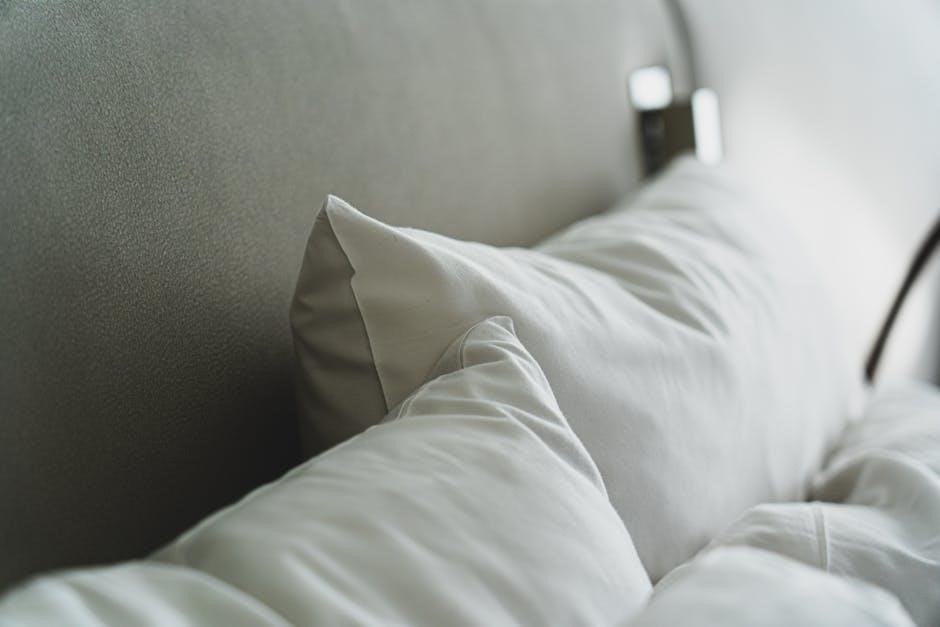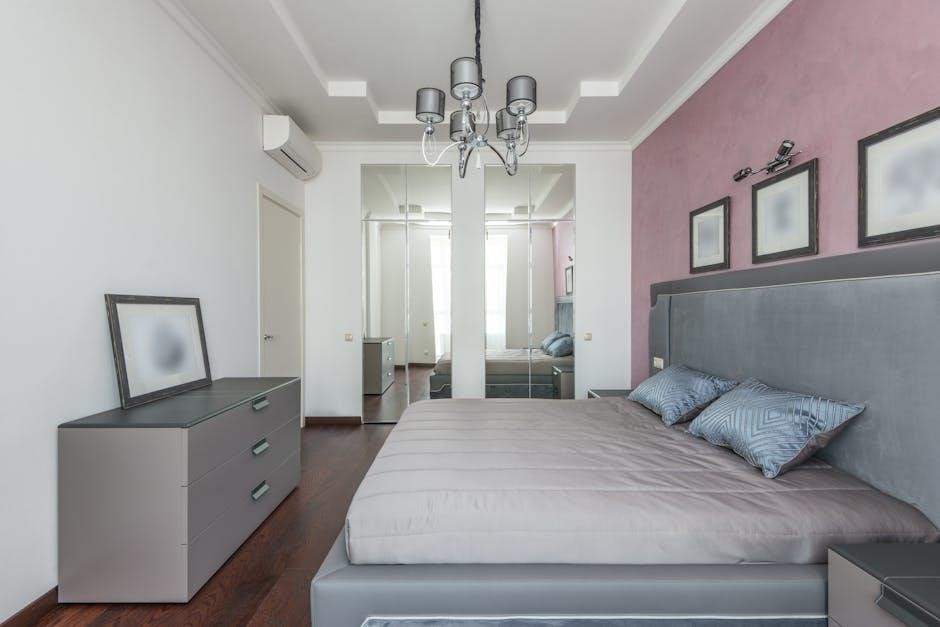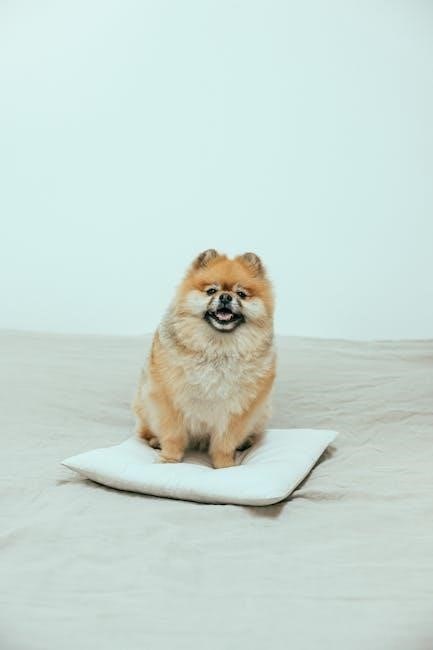pillow insert size guide
Pillow inserts are essential for both comfort and aesthetics, available in various sizes and filler materials. The right size enhances both support and visual appeal significantly.
Why Pillow Insert Size Matters
Pillow insert size is crucial for both comfort and aesthetics. A properly sized insert ensures the pillow fills out its cover evenly, maintaining shape and preventing a flat appearance. The right size enhances support for the head and neck, promoting proper alignment during sleep. Additionally, it impacts the visual appeal of decorative pillows, with a larger insert creating a fuller, more luxurious look. Choosing the correct size is essential for functionality and style, ensuring your pillows look their best and provide optimal comfort.

Standard Pillow Insert Sizes
Standard pillow inserts typically come in sizes like 18×18, 20×20, and 22×22 inches, fitting most common pillow covers. These sizes ensure a proper fit and optimal support.
Common Pillow Insert Dimensions
Common pillow insert dimensions include 18×18, 20×20, and 22×22 inches, which are standard for most home decor applications. These sizes ensure a snug fit within pillow covers and provide a full, plush appearance. Lumbar pillow inserts often measure 16×24 inches, while bolster inserts can range up to 6×24 inches for longer support. These dimensions are designed to complement various pillow covers seamlessly, ensuring both aesthetic appeal and comfort. Choosing the right size is key to achieving the desired look and feel for your space.
Understanding Square vs. Rectangular Inserts
Square pillow inserts are the most common, typically available in sizes like 18×18, 20×20, or 22×22 inches, perfect for standard pillow covers. Rectangular inserts, such as lumbar or bolster pillows, offer a longer shape, often measuring 16×24 inches or 6×24 inches. Square inserts provide a balanced, uniform appearance, while rectangular ones add a unique decorative or functional element. Choosing between square and rectangular depends on the desired aesthetic and purpose, ensuring the right fit for both comfort and style in your home decor.
How to Measure Your Pillow Cover
Measure from interior seams of the pillow cover to determine its exact size, ensuring accuracy for selecting the correct insert size, typically 1-2 inches larger.
Step-by-Step Guide to Measuring Your Pillow Cover
To accurately measure your pillow cover, start by laying it flat on a surface. Remove any inserts to ensure precise dimensions. Measure the length and width by aligning a ruler or tape measure with the interior seams. Note the thickness of the fabric and any seam allowances, as these can affect the fit of the insert. For a standard square cover, measure from one seam to the opposite seam. Record these measurements to determine the ideal insert size, typically 1-2 inches larger for a fuller appearance.
Understanding Seam Allowances and Fabric Thickness
Seam allowances and fabric thickness play a crucial role in determining the best fit for your pillow insert. Seam allowances refer to the extra fabric added during stitching, which can slightly reduce the cover’s interior dimensions. Fabric thickness affects how snugly the insert fits inside the cover. Thicker fabrics may require a slightly larger insert to maintain a smooth appearance; When measuring, consider these factors to ensure the insert fills the cover evenly, avoiding a loose or overly tight fit that could compromise comfort and aesthetics.

Choosing the Right Filler Type
Pillow inserts come in various filler types, including down, down alternative, memory foam, and feather options. Each offers unique benefits, such as loft, support, and allergy considerations.
Popular Filler Materials for Pillow Inserts
Pillow inserts are available in various filler materials, each offering distinct benefits; Down inserts provide luxurious loft and softness, while down alternative mimics the feel without animal products. Memory foam inserts offer superior support and pressure relief, ideal for those seeking firmness. Feather inserts are lightweight and affordable, though less durable. Each material caters to different preferences, whether for comfort, allergy concerns, or budget. Choosing the right filler ensures optimal support and longevity, enhancing both the functionality and aesthetic appeal of your pillows.
Down vs. Down Alternative: What’s Best for You
Choosing between down and down alternative pillow inserts depends on personal preferences and needs. Down inserts offer exceptional loft, softness, and durability, making them ideal for a luxurious feel. However, they may not be suitable for those with allergies or ethical concerns. Down alternative inserts mimic the look and feel of down but are hypoallergenic and vegan-friendly, often made from synthetic materials. For natural, long-lasting comfort, down is a timeless choice. For allergy sufferers or those seeking cruelty-free options, down alternative provides a comparable experience without compromise.

Understanding Filler Density and Loft
Filler density determines support, with higher density providing firmer pillows. Loft refers to thickness, affecting comfort and suitability for different sleeping positions, ensuring proper spinal alignment.
How Filler Density Affects Pillow Support
Filler density plays a crucial role in pillow support, with higher density offering greater firmness and stability. For side sleepers, denser fills provide the necessary neck and spine alignment. Back sleepers benefit from medium density, while stomach sleepers prefer softer options. Materials like down or down alternatives vary in density, affecting overall comfort. Choosing the right density ensures proper support, enhancing sleep quality and maintaining the natural curvature of the spine. This balance is key to achieving a restful and rejuvenating sleep experience.
Loft Levels: High, Medium, or Low
Loft levels determine the thickness and firmness of a pillow insert, impacting both comfort and appearance. High loft inserts provide maximum support and are ideal for side sleepers, while medium loft offers a balanced feel suitable for back sleepers. Low loft inserts are best for stomach sleepers or those who prefer a softer, flatter pillow. The right loft ensures proper spinal alignment and enhances sleep quality. Additionally, loft levels affect the pillow’s visual appeal, with higher lofts creating a fuller, more luxurious look in decorative covers.

How to Select the Perfect Insert Size
Selecting the perfect insert size ensures a full, supportive pillow. Use the 1-2 inch rule: choose an insert slightly larger than the cover for optimal comfort and appearance.
The 1-2 Inch Rule: Sizing Up for a Fuller Look
The 1-2 inch rule is a simple yet effective guideline for achieving a plush, well-filled pillow appearance. By selecting an insert 1-2 inches larger than the pillow cover, you ensure a fuller look and optimal comfort. This sizing strategy prevents the insert from appearing flat or overly stuffed, creating a balanced and inviting aesthetic. Measuring the cover accurately and considering the filler type are key to implementing this rule successfully. It’s a straightforward approach to elevate both the visual appeal and functionality of your pillows.
When to Choose the Same Size Insert
Choosing the same size insert as your pillow cover is ideal for functional pillows, such as those used for sleeping, where a snug fit is preferred. It ensures proper support and prevents excessive bulk. Same-size inserts are also suitable for lumbar pillows or cases where a precise fit is necessary. However, for decorative purposes, sizing up is usually recommended. Always measure your cover accurately, considering seam allowances, to determine the best fit for your needs. This approach ensures comfort and a polished appearance tailored to the pillow’s intended use.

Specialty Pillow Inserts
Specialty inserts, like lumbar or bolster pillows, cater to unique needs, offering tailored support and shape for specific uses, ensuring both comfort and proper functionality.
Lumbar Pillow Inserts: Size and Shape Considerations
Lumbar pillow inserts are designed for back support, typically featuring a curved or contoured shape to fit the natural arch of the spine. Their size usually ranges from 20×14 inches to 24×16 inches, depending on the intended use; For a snug fit, inserts should match or slightly exceed the cover’s dimensions. Opting for a 1-2 inch larger insert ensures a fuller appearance. The shape and size must align with the pillow cover’s design to provide optimal support and maintain aesthetic appeal, making them ideal for chairs, car seats, or decorative settings.
Bolster and Neck Pillow Inserts: Unique Sizing Needs
Bolster and neck pillow inserts have distinct sizing requirements. Bolster inserts are typically longer and cylindrical, often measuring 6×20 inches, while neck pillows are contoured for cervical support, usually around 12×16 inches. For bolsters, the insert should closely match the cover’s length and diameter to ensure a snug fit. For neck pillows, sizing varies, but they should fit snugly to maintain proper spinal alignment. Choosing the right size ensures optimal support and comfort, making them ideal for both decorative and functional purposes in various settings.
Caring for Your Pillow Inserts
Proper care extends the life of pillow inserts. Wash and dry according to fabric type, fluff regularly to maintain shape, and store in a clean, dry place.
Washing and Drying Tips

Wash pillow inserts in a gentle cycle with mild detergent to preserve materials. For down or down-alternative fills, check labels for specific instructions. Air-dry or tumble-dry on low heat, fluffing occasionally to maintain loft. Avoid fabric softeners, as they can reduce material breathability. Store inserts in a clean, dry place to prevent moisture buildup. Regular washing and proper drying ensure longevity and maintain the shape of your pillow inserts, keeping them comfortable and visually appealing over time.
How to Fluff and Maintain Pillow Inserts
Regular fluffing and shaking of pillow inserts helps maintain their shape and loft. For down or down-alternative inserts, reshape them after washing and allow to air-dry completely. Fabric type may require specific care, so always check labels. To keep inserts fresh, store them in a cool, dry place away from direct sunlight. Fluffing daily ensures they remain plush and visually appealing. Proper maintenance extends the life of your pillow inserts, keeping them comfortable and looking their best over time.

Troubleshooting Common Issues
If your pillow insert looks flat, fluff it thoroughly or replace it. For visible edges, adjust the cover or opt for a slightly larger insert size.
Why Your Pillow Insert Might Look Flat
Your pillow insert might look flat due to improper sizing or insufficient filler material. If the insert is too small for the cover, it won’t fill out the fabric properly, resulting in a flat appearance. Over time, natural fillers like down may lose loft, while synthetic materials can compress. To fix this, ensure your insert is 1-2 inches larger than the cover and fluff it regularly. Consider replacing the insert if it no longer maintains its shape or loft, especially after extended use.
Fixing Visible Insert Edges
Visible insert edges can detract from the appearance of your pillows. To fix this, ensure your pillow insert is the correct size—ideally 1-2 inches larger than the cover. This ensures the fabric drapes smoothly without pulling tight; If edges are still visible, try using a thicker filler material or adjusting how the insert sits inside the cover. Fluffing the insert regularly and tucking any excess fabric into the seams can also help create a seamless, polished look. Proper sizing and maintenance are key to avoiding this issue.
Selecting the right pillow insert size and type is crucial for both comfort and aesthetics. Proper sizing ensures a polished look and lasting support, enhancing your space.
Final Tips for the Perfect Pillow Setup
For a polished and inviting space, ensure your pillow inserts are 1-4 inches larger than the covers for a full, luxurious appearance. Consider the room’s style and your personal comfort preferences when selecting filler materials. Layer pillows of varying sizes to create visual interest, with larger ones at the back and smaller ones in front. Fluff inserts regularly to maintain their shape and support. Finally, match the insert size to the cover’s dimensions for a cohesive, professional look that elevates any room’s decor.

